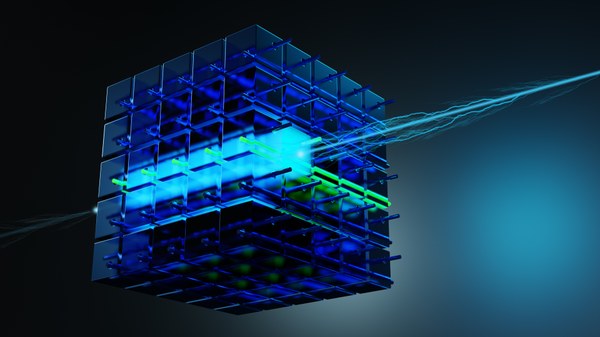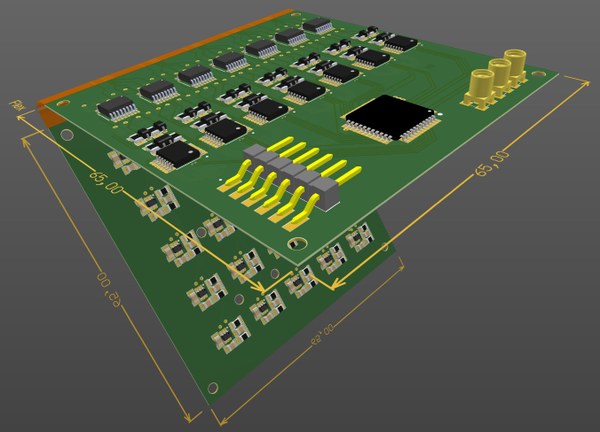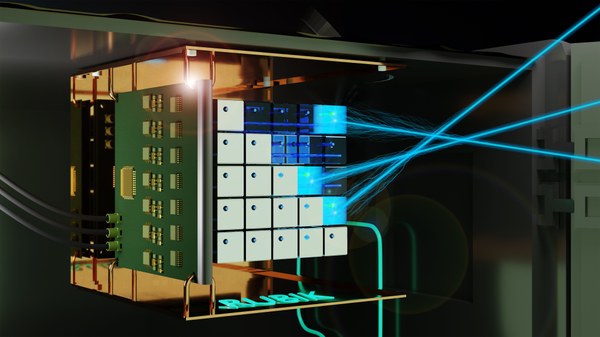RUBIK
| The search for the origin of high-energetic cosmic rays with energies above PeV (1015 eV) is still an open question [1]. Recently, a galactic source could be pinned down as a possible source [2]. Besides the unknown origin, the acceleration process or possible mechanisms of energy transfer on this scale remain unclear. An answer to such questions could be formulated if the origin of such events were known. To identify these particles (≈ 90 % protons, ≈ 9 % helium and ≈ 1 % heavier nuclei), it is necessary to observe them outside our atmosphere since the particles interact with the atmospheric nuclei. The result of this interaction is the production of highly energetic secondary particles in an air shower extending to the earth’s surface with a footprint radius, depending on the energy of the primary particle, of several meters to several tens of kilometers. The secondary particles are the only way to reconstruct the properties (kinetic energy and momentum vector) of the primary particle on earth. A more direct way would be to measure the trajectory of the primary particle using an orbiting detector platform in space. |  |
|
| Therefore, we propose the RUBIK detector, which, in analogy to the famous Rubik’s cube jigsaw puzzle, consists of a number of small active cubes (1×1×1 cm3 ) made out of scintillation material and covered with highly reflective foil. To access the scintillation response of each cube, each row and column of cubes is penetrated by two wavelength shifting (WLS) fibers in perpendicular directions. By stacking 25 of the cubes in 5 layers, a segmented detection volume is created with the ability to reconstruct a three-dimensional particle trajectory. The WLS fibers act as light guides and are terminated in a photosensitive silicon photomultiplier (SiPM) with subsequent readout electronics and signal processing. The digitized signals after a threshold discriminator from each channel are fed into a trigger generator which asserts an event trigger, once a reasonable combination and multiplicity of channels have shown a coincident signal above an adjustable threshold. The sparsified event pattern allows a 3D reconstruction of a trajectory through the detector array. An event time stamp, accurate to tens of nanoseconds, is maintained for later correlation with other orbital or ground detectors. The time stamp is derived from a local oscillator locked to the carrier frequency of the GNSS satellites via the PPS signal from the on-board GNSS receiver. This timing correlation of primary particles with the signals from other primary detectors (in orbit) or ground-based shower detectors, which evaluate the signals of the secondary particle cascade triggered by the detected primary particle is an unprecedented feature. Latter detectors exist in abundance as part of many different research and citizen science projects as the MuonPi project. The RUBIK payload, part of the Research and Observation in Medium Earth Orbit (ROMEO) satellite mission [4,5], will fit into a 1U cubesat volume (10 × 10 × 10 cm3 ) and is therefore considered as a proof-of-concept demonstrator for the primary particle trajectory reconstruction and the correlation with a ground-based secondary particle detector array. |
 |
|
| The proposed payload is primarily a demonstration for fundamental science purpose but it will certainly generate valuable data that can be used by other scientists and agencies, e.g. to find correlations between space weather and atmospheric weather phenomena, such as the suspected thunderbolt seeding mechanism. The correlation between primary particles and the secondary air showers produced will also provide a new, more direct observable for the shower generation mechanisms which can be fed as an extension into a model of a transport simulation model (e.g. GEANT, MCNP, CORSIKA). Finally, it has been indicated that these ultrahigh-energy particle cascades could have an impact on the global climate [6]. |  |
[1] A.A Watson (2000), Ultra-high-energy cosmic rays: the experimental situation, Physics Reports, https://doi.org/10.1016/S0370-1573(00)00027-2
[2] Ke Fang, et. al. (2022). Evidence for PeV Proton Acceleration from FermiLAT Observations of SNR G106.3+2.7. Phys. Rev. Lett. 129, 071101
[3] https://muonpi.org
[4] https://irs.uni-stuttgart.de/en/research/satellitetechnology-and-instruments/smallsatelliteprogram/romeo
[5] Löfflera, et. al. (2022). Preliminary Design of the Radiation Protection of the ROMEO Satellite in the lower Medium Earth Orbit.
[6] Carslaw, K. S., Harrison, R. G., Kirkby, J. (2002). Cosmic rays, clouds, and climate. science, 298(5599), 1732-1737
